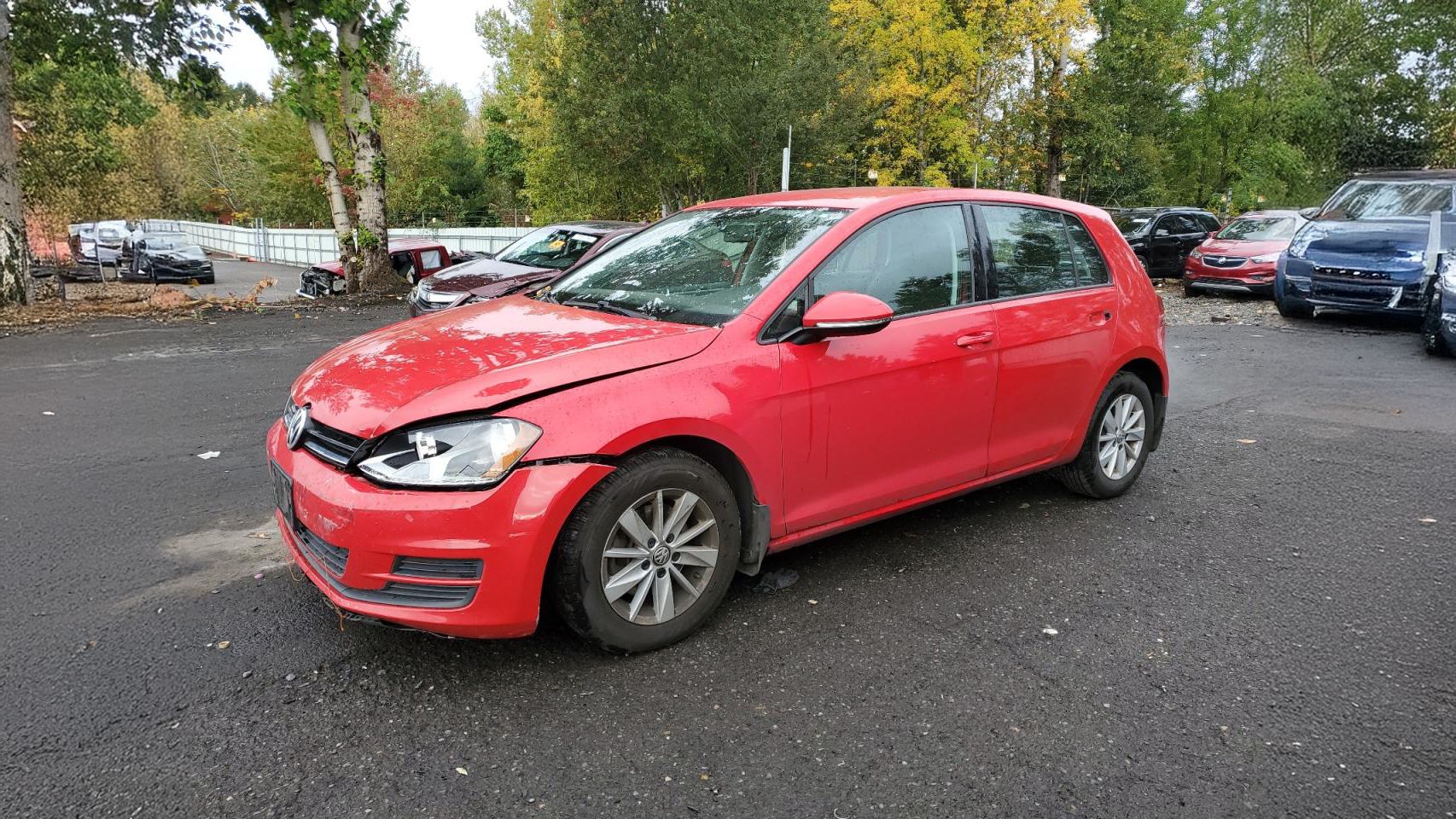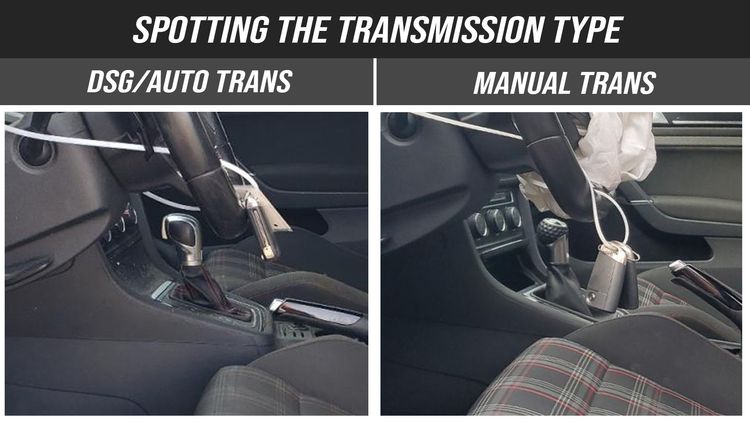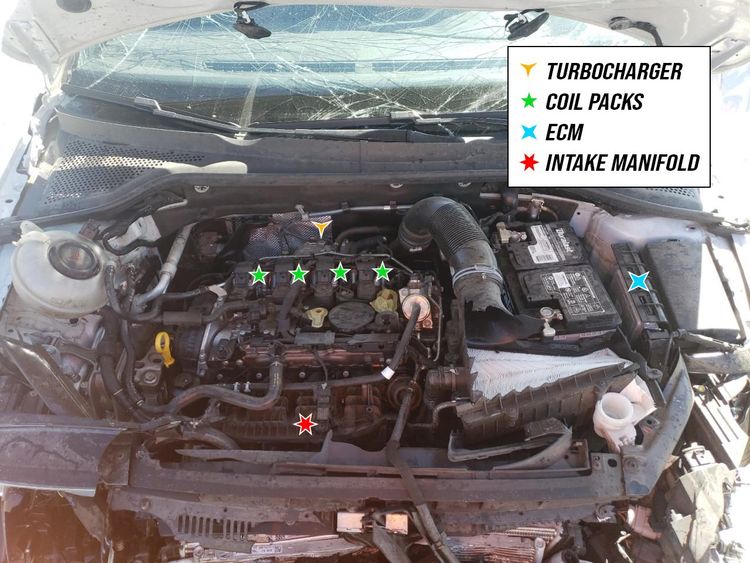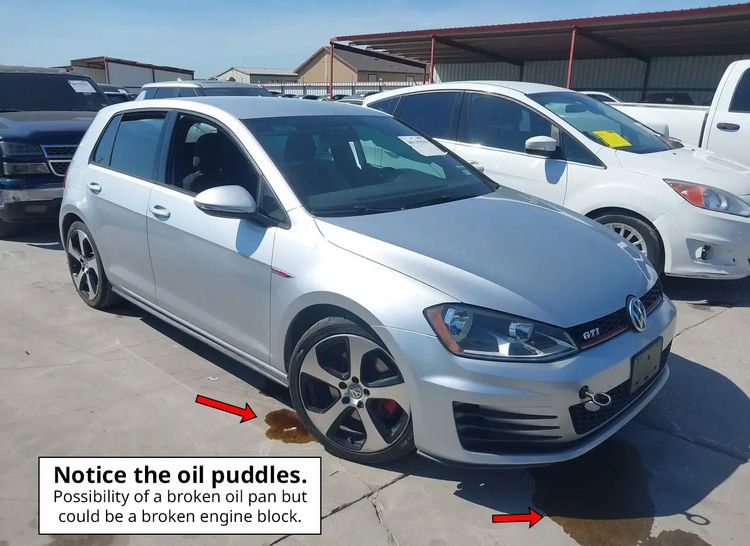Goblin V2 Donor Buying Guide

Introduction
Welcome to the Goblin V2 Donor Buying Guide! This guide is designed to help you choose the ideal Mk7 Volkswagen Golf donor for your Goblin V2 build. Whether you’re considering a 1.8T or GTI, and whether you're buying through a private sale on platforms like Facebook Marketplace or at auction with Copart and IAA, this guide will walk you through what to look for and how to narrow down your options to find the perfect fit.
The goal here is to make the buying process as easy as possible, ensuring that whichever route you take, you end up with a donor that maximizes your build's potential. With some straightforward guidance, you'll be able to determine the best year, trim, and condition for your budget and build goals, setting you up for a smooth and exciting build process.
Acceptable Years for the Golf Mk7 (2015-2021)
When choosing a Golf Mk7 as the donor car for your Goblin V2, you’ll be happy to know that any model year of the Mk7 Golf 1.8T (2015–2020) or GTI (2015–2021) will work. While there are some differences in horsepower and DSG transmission options across the years, all are fully compatible with the Goblin V2.
Horsepower
- Golf 1.8T (2015–2020): Across all years, the 1.8T delivers 170 horsepower out of the box.
- Golf GTI (2015–2021): The GTI’s stock horsepower ranges from 210–228 horsepower.
- 2015–2018 models offer 210 to 220 horsepower depending on trim level
- 2019–2021 models offer 228 horsepower at all trim levels.
Transmission Details
- Golf 1.8T (2015–2020): Offers a traditional torque converter automatic or a 6-speed manual transmission throughout all model years. Both options integrate seamlessly into the Goblin V2.
- Golf GTI (2015–2021):
- 2015–2018 models feature the 6-speed DSG transmission, known for its quick shifts and reliability.
- 2019–2021 models upgraded to the 7-speed DSG transmission, which provides even faster shifts and greater durability. Both DSG variants are excellent choices and fully compatible with the Goblin V2.
1.8T Golf vs GTI: Which Model is for You?
When it comes to the Mk7 Golf as a donor for your Goblin V2, you’ve got two solid options: the 1.8T or the GTI. The 1.8T is the reliable base model, while the GTI steps up with more power and access to a high-performance dual-clutch DSG transmission. Both come turbocharged, so even the base 1.8T has plenty of potential to give your Goblin some serious kick.
Horsepower (Stock and Tuned)
- Golf 1.8T: Straight out of the factory, the 1.8T makes 170 horsepower. But with a tune, it can jump to around 250 horsepower using its stock IS12 turbocharger.
- Golf GTI: Depending on the year, the GTI starts with 210–228 horsepower. With a tune, it can rocket to 350+ horsepower with the stock IS20 turbo. Swap out the turbo, and you’re looking at even bigger numbers.
Transmission Choices
- Golf 1.8T: You can find the 1.8T with a 6-speed manual or a traditional torque converter automatic.
- Golf GTI: The GTI offers a 6-speed manual (stronger than the one in the 1.8T) or the dual-clutch DSG transmission. The DSG is the standout here, delivering lightning-fast shifts that make it an excellent choice for anyone seeking peak performance.
Availability
- Golf 1.8T: The base Golf 1.8T is about twice as common as the GTI, making it easier to find and usually more affordable.
- Golf GTI: The GTI is slightly harder to come by and costs more, but it brings more power and a better transmission option right out of the box.
Trim Levels: Don’t Overthink It
When picking a Golf 1.8T or GTI as your Goblin V2 donor, you might be wondering, “Does the trim level matter?” The short answer? Not really. Trim levels mostly affect things you won’t even use in the Goblin, so you’re free to focus on finding a good donor without sweating the details.
Golf 1.8T: Just Comfort Features and Appearances
With the 1.8T Golf, trim levels just change the fancy stuff—like the seat materials, automatic climate control, or lighting packages. None of these make a difference for your Goblin V2 build. The mechanical parts you’ll reuse are the same across all trims, so go with whatever fits your budget and availability.
GTI: A Few Extras That Won’t Matter
The GTI trims can include performance packages, but even these don’t really benefit your Goblin build.
GTI Performance Package
- Adaptive Suspension: Cool feature for the Golf, but the Goblin has its own suspension, so this won’t carry over.
- Electronic Limited-Slip Differential (ELSD): It’s a neat system in the Golf, but the Goblin doesn’t use the sensors needed for it to work. Bonus: if your donor has one, removing it will save you almost 25 pounds.
- Upgraded Brakes: Bigger, heavier brakes might sound better, but the Goblin is so light it doesn’t need them. Our kit includes brakes tailored to the car’s weight and performance.
GTI Horsepower Differences
Different trims and years of the GTI will have slightly different stock horsepower levels, thanks to VW tuning the engine for more power over time. The changes are small and won’t matter if you plan to flash a tune after your Goblin is built. Aftermarket tunes bring GTI engines up to similar levels regardless of the year or trim.
Dual Clutch vs Automatic vs Manual
Picking the right transmission for your Goblin V2 donor is all about knowing what you want from your build. The Mk7 Golf offers three options: a torque converter automatic, a dual-clutch DSG, and a manual. Each has its pros and cons, so let’s break it down and see which fits your style.
Dual-Clutch DSG
The DSG (Direct Shift Gearbox) is the star performer, found in the GTI models. It’s a dual-clutch automatic that delivers lightning-fast shifts and even has a tap-shift feature for extra control. It’s also a tuning powerhouse—just a DSG tune can handle builds pushing 500+ horsepower. Starting in 2019, VW upgraded the DSG from 6-speed to 7-speed, adding even more performance and efficiency.
Note: When searching for a GTI with a DSG transmission, it will typically be listed as "automatic." However, the DSG is the only automatic transmission available in the Mk7 GTI. There are no GTI models with a torque converter automatic, so any automatic GTI you find will have the DSG.
- Pros: Quick shifts, excellent for high-performance builds, great for big power upgrades.
- Cons: Heavier than other transmissions, may require more maintenance.
Torque Converter Automatic
This one is only found in the Golf 1.8T. It’s a simpler, lighter transmission than the DSG but not as performance oriented. While it can handle the 1.8T’s stock IS12 turbo, pushing it too hard with bigger turbos can cause trouble.
- Pros: Lighter than the DSG; simpler and reliable for stock setups.
- Cons: Less performance-oriented; not ideal for larger turbo setups.
Manual Transmission
For the more connected feeling many enthusiasts prefer, the Golf 1.8T offers a 5-speed manual, while the GTI comes with a 6-speed manual. The 5-speed is reliable for tuned power and the 6-speed is strong enough for a turbo swap, but both transmissions share one limitation: the stock clutch is a limiting factor, so an upgrade is a must if you plan on tuning.
- Pros: Full driver control; more engaging experience; generally easier to maintain.
- Cons: Not as fast as the DSG for shifting, Will require an upgraded clutch when tuned.

One good way to confirm the donor you are looking at online has the correct transmission type is to look at the gear selector. DSG and automatic cars have an oblong knob with a button at the front. The manual donors have a golf ball style shifter.
Where to Buy a Donor
When it’s time to find a donor vehicle for your Goblin V2 build, you’ve got a few solid options—each with its own pros and cons. The three most popular places to look are salvage auctions (like Copart and IAA), private sales (such as Facebook Marketplace), and used car lots.
Salvage Auctions (Copart and IAA)
Salvage auctions like Copart and IAA are a budget-friendly way to source a Mk7 Golf. These auctions are packed with vehicles at lower prices, but most are totaled due to damage. That’s not a big deal for a Goblin donor since you only need specific parts, but you’ll want to carefully inspect the auction photos for anything that might affect the pieces you need.
Understand that there is always a risk the car could have damage beyond what you can spot in the photos.
- Pros: Lower prices and large availability.
- Cons: Potential for hidden damage, may require a broker, and unloading logistics can be tricky.
Private Sale (e.g., Facebook Marketplace)
Private sales, like those on Facebook Marketplace, let you connect directly with the seller. You can ask all the questions you want, take the car for a test drive, and negotiate the price to get a deal that works for you. It’s a more hands-on process, but it can help you feel confident about the car’s condition before committing.
- Pros: Direct contact with the seller, a chance to inspect and test drive, and more room to negotiate.
- Cons: Usually pricier than auctions and requires more legwork going to check out cars in person.
Used Car Lots
Used car lots can be a good choice if you’re looking for peace of mind. Dealers often inspect and recondition the cars they sell, so you’ll know the vehicle is in decent shape. Of course, this confidence comes at a cost—dealership prices are generally higher.
- Pros: Inspected and possibly reconditioned cars, smoother buying process.
- Cons: Much higher prices.
What to Expect to Spend on a Donor
When it comes to finding the right donor for your Goblin V2, the cost can vary depending on where you look and what condition the car is in. Salvage auctions typically offer the best deals, with final bid prices as low as $1,500 or $2,000 (plus about $1,000 in fees). Private sales are more expensive, usually ranging from $10,000 to $15,000, while used car lots are the priciest option, sometimes pushing $20,000.
Salvage Auctions Prices
If you’re looking for the best bang for your buck, salvage auctions like Copart and IAAI are where you'll find it. These auctions are full of cars that are no longer roadworthy but still have all the parts you need for your build.
2024 Golf Mk7 Auction Data
We dug into the numbers from 2024 and found some great deals for Mk7 Golfs that meet Goblin donor criteria (no burn or flood damage, no stripped cars, under 125,000 miles). Here’s what the data shows:
- Golf 1.8T: 490 cars sold for under $2,500, with a median final bid price of $1,595.
- Golf GTI: 215 cars sold for under $3,500, with a median final bid price of $2,042.
Not bad, right? Just remember to account for auction fees when budgeting.
Facebook Marketplace or Private Sale
If you prefer to interact directly with a seller, Facebook Marketplace or other private sale platforms are a solid option. You’ll typically find cars in better condition than at an auction, but you’re also paying for that convenience. Prices usually fall between $10,000 and $15,000, depending on factors like mileage, trim, and location. It’s a great way to get a clearer picture of what you’re buying, but you’ll pay more than at an auction.
Used Car Lot
For the easiest, most hassle-free option, head to a used car lot. These cars are clean, ready to drive, and often reconditioned by the dealer. But that peace of mind comes at a premium—a clean GTI could set you back as much as $20,000. If budget isn’t your main concern, this is the simplest way to go.
Buying from Salvage Auctions (Copart and IAA)
Salvage auctions like Copart and IAA can be a fantastic way to find a donor Mk7 Golf for your Goblin V2. They often have a huge selection at lower prices, but there are a few things to keep in mind. Depending on the auction, you might need a broker to help with the purchase—especially for vehicles that require specific licenses. And don’t forget about logistics: figuring out how the donor will be delivered and unloaded can be tricky, especially if the car is heavily damaged or doesn’t run.
Using Brokers to Purchase at Auction
The rules for buying salvage vehicles vary by state, and in some cases, you’ll need a broker to bid for you. If a car requires a license you don’t have, brokers like AutoBidMaster (for Copart) and SCA (for IAA) can handle the bidding process. You set your max bid on their site, and they take care of the rest. Just be aware that brokers charge fees for their services, so factor that into your budget. The upside? Using a broker gives you access to a wider selection of cars.
Donor Vehicle Delivery and Unloading
When buying a donor from an auction, keep in mind how the car will be unloaded when it gets to your home or business. At the auction lot, donor cars are typically loaded onto trailers with a forklift. This means that when the delivery driver arrives, your car might be positioned between other vehicles on the trailer, which can make unloading tricky without a forklift.
If you do not have access to a forklift that can lift the donor off the trailer, you need to take extra care when arranging the car's delivery.
Once you’ve won your auction, the next big challenge is getting the car delivered and unloaded. Donor cars are usually loaded onto trailers with forklifts, and when they arrive, they might be tucked behind or between other vehicles. If you don’t have a forklift to unload the car, things can get tricky.
Pro Tip: If you don’t have a forklift or similar equipment, consider sticking to auctions close to home. That way, you can hire a flatbed tow truck to deliver the car or even pick it up yourself with a trailer. This can make unloading a lot easier and help you avoid the hassle of dealing with boxed-in vehicles or specialized unloading gear.
A Heads-Up About Shipping
Some brokers (like AutoBidMaster) require you to use their shipping services if you’re buying a car in your own state. This means you won’t have control over how the car is loaded or delivered. Keep this in mind when bidding to make sure their shipping policies work for you—not against you.
Condition of the Donor Vehicle
No matter where you buy your donor car, the condition of the vehicle is key. Since you’re only reusing certain parts for your Goblin V2, you want to make sure those parts are in good working order. Keep an eye out for high mileage, flood or fire damage, or anything else that could compromise the components you need.
General Condition of the Car
- Mileage Ideally Under 125,000
- There’s no hard limit on mileage but lower miles generally mean less wear and tear. Look for mileage under 125,000.
- Primary/Secondary Damage (if bought at auction)
- Avoid donors with damage listed as FIRE, FLOOD, ENGINE, or STRIP. These often mean critical parts are missing or damaged. Also, keep in mind that many states won’t register cars using parts from flood-damaged vehicles.
- Engine Starts/Car Drives
- At auctions, look for terms like “runs and drives” or “engine starts.” These indicate the engine is functional. If the listing says “stationary,” the auction house didn’t try to start it, so proceed with caution.
- Key
- The Goblin V2 can work with or without the donor key. If you plan to use the key, you’ll need the ignition switch and gauge cluster from the donor to integrate them into your Goblin. No key? No problem—just plan on buying an EcuTek system. Not only can it disable the immobilizer, but it’s also used by many Mk7 Golf tuners.
Condition of the Powertrain and Engine Bay
- Pay Attention to Front End Damage
- Heavy front-end damage is common, but inspect the photos closely to make sure it didn’t impact critical powertrain components.
- Front Wheel/Suspension Damage
- The Goblin V2 doesn’t reuse the Golf’s suspension, but if something hit the front wheel hard enough to push into the powertrain, check for damage to the block, oil pan, or transmission.
- Radiator Damage is Okay
- The Goblin V2 doesn’t reuse the radiator, so a damaged one is no big deal.
- Intake Manifold Needs to Be Intact
- Front-end impacts can break the intake manifold if the crossmember is pushed back. Make sure it’s undamaged—you’ll need it for the build.
- Consider Damage Under the Powertrain
- Look for signs of low-impact damage under the car. Scrapes or dents near the oil pan, engine block, or transmission could mean trouble.
- The Engine Needs to Be Complete
- Watch for stripped engines. Ideally, the plastic cover over the valve cover is intact, indicating that the engine is likely still intact. But if the cover is missing, confirm that the coil packs and turbocharger are still there. Also, check for the ECM on the driver’s side of the engine bay.

This donor has front end damage but the labeled parts all appear to be intact. The turbocharger, coil packs, and ECM are still installed. The intake manifold does not appear to be damaged.

This donor appears to be in good shape but the fresh oil puddles coming out from under the car are notable. This could be as simple as a cracked oil pan or as bad as a broken engine block. Be careful with donors like this.